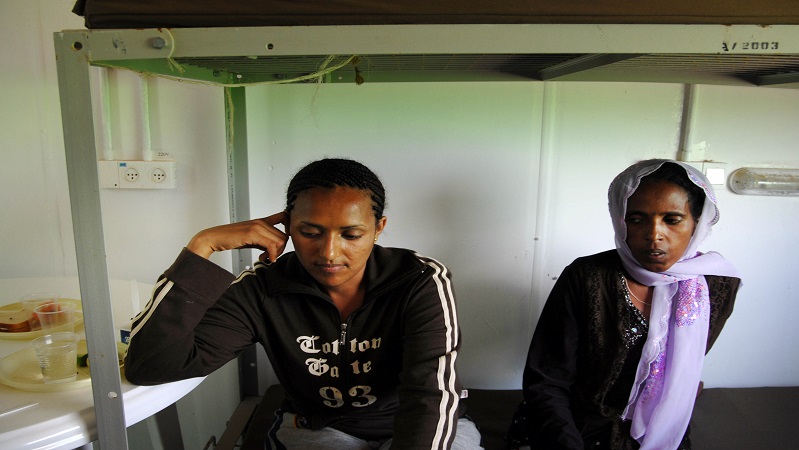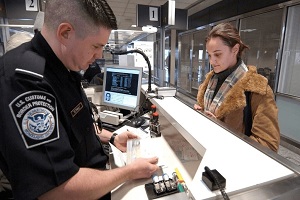America’s Prisons For Refugees By Jack Craver
We have drug dealers coming across, we have rapists, we have killers, we have murderers.” This is the slander against Latin American immigrants made famous by Donald Trump. Unfortunately, it is only a couple of words away from the truth. Murder and rape are indeed major drivers of immigration to this country. But those flooding over the borders are almost all victims, not perpetrators.
The majority are women. Almost all have been beaten, many have been raped, and many have seen friends and family murdered. They come to the United States out of desperation, hoping the Land of Opportunity will let them live, work, and raise a family in peace.
“My father taught me that we need to risk to gain,” says Rosa, a nineteen-year-old who fled El Salvador after her father was murdered trying to protect her from the gang leader who raped her. “In this case, we need to risk not to die.”
Rosa is one of seven former detainees I interviewed in recent months, all now living in Austin, Texas, some still awaiting decisions on their status. All but one agreed to talk only if I didn’t use real names.

Some fear exposing themselves or their families to reprisals; others worry that speaking frankly about the poor treatment they endured as detainees could jeopardize pending legal proceedings in the United States. Both concerns are well founded.
These refugees, all once housed in one of several detention centers in Texas, cannot be blamed for lacking faith in the U.S. legal system. Many have played by the rules and still been treated like criminals—not just by Trump, but by leaders typically regarded as sympathetic to immigrants, most notably President Obama.
While the President has championed bringing undocumented immigrants who have lived in the United States for years out of the shadows, his administration has also responded to the uptick in Central American refugees by seeking to quickly detain and deport thousands of women and children.
Not only are they unwelcome in our country, their time here is often spent behind bars, a cruel irony, since they are the victims, not the perpetrators, of crimes.
Tina, a twenty-nine-year-old Mexican woman, has a typical story. A restaurant owner in a small town, she was kidnapped one night by a group of police officers looking for money. They demanded a ransom of half-a-million pesos (roughly $28,000), which she insisted she didn’t have.
To make sure she was telling the truth, they tortured her for a week, holding her head under water and shocking her with electric cords. When they were through, they delivered her to a judge on trumped-up charges of drug trafficking.
All of those details she recounts matter-of-factly, in Spanish. It is only later in the conversation, when she mentions that she was raped by guards during the nine months she subsequently spent in prison, that tears spring from her eyes.
“I knew that at least here that would not happen,” she says, explaining her decision to come to the United States.
Tina had spent time in this country years ago as an undocumented worker, cleaning houses and sending money back home, a situation prompted by her ailing father’s medical bills. This time, her decision to come to Texas had nothing to do with making money, only with saving her life.
When she arrived at the border with her husband and daughter and told a border agent that she sought asylum in the United States, she was told she would have to be detained if she crossed. Without other options, she surrendered herself to the U.S. Border Patrol.
The Border Patrol, says Tina, did everything it could to get her to turn back. Like other refugees I spoke to for this story, Tina recounted being put in a room where the air conditioning is turned up to levels that leave its occupants shivering. Their requests for sweaters or coats were refused.
Immigration groups contend this is a form of torture to coerce detainees into signing deportation papers. The Border Patrol has insisted that its agents do not purposefully expose detainees to extreme temperatures, but immigrant rights advocates point out that the stories of such conditions are so common that the infamous room has even earned a nickname: la hielera, or the icebox.
“Abuse is rampant,” says Kate Lincoln-Goldfinch, an immigration attorney in Austin. “The food is terrible, if it comes at all. The lights are on 24/7. People are discouraged from claiming asylum. They’re told if they claim asylum, they’ll just be detained for weeks and weeks.”
The apparent goal is to get detainees to sign deportation papers, relinquishing their right to seek legal asylum. Sometimes they do; sometimes they don’t.
“They were very angry but I said no, I’m not going to sign,” relates Rosa. “The only thing in my mind was what was going to happen if they send me back to El Salvador.”

The T. Don Hutto Residential Center, one of the nation’s seventy-nine U.S. immigrant detentions centers—and one of eleven in Texas—is located just north of Austin. It is a for-profit prison, run by Corrections Corporation of America.
Conditions at Hutto, a former detention center for families that now houses only adult women, have improved for detainees since the U.S. Immigration and Customs Enforcement (ICE) settled a 2007 lawsuit brought by the ACLU. Previously, explains Lincoln-Goldfinch, “It was full-on prison. They were in their cells twelve hours a day. There wasn’t even an attempt to make it look cheerful.”
Lincoln-Goldfinch remembers one family she represented: “Their baby was in a prison-issued little onesie and the mom asked me to hold her because she said I smelled like the outside world.” While things have improved, she says, “it’s still a jail.”
“It’s crazy,” says Joel Gonzalez, a former ICE prosecutor who now runs an immigration law practice in San Antonio. “The idea that somewhere in our laws are embedded guarantees to these for-profits is crazy.”
Reviews of the conditions at the detention centers are mixed. One former detainee I spoke with was able to receive medical attention and eventually see a therapist. But Betty, another El Salvadoran woman, says that when she pointed out bruises on her neck from days of sexual abuse by traffickers, a guard laughed it off, saying some women liked to be roughed up. Says Gonzalez, “GEO and Corrections Corporation have not really impressed me in terms of their operations.”
Rosa joined dozens of other women at Hutto in a hunger strike to protest scarce rations, demeaning treatment by staff, and, of course, their confinement.
ICE has denied the strike took place, but Grassroots Leadership, an Austin-based immigrant rights group, obtained nineteen handwritten letters from detainees who gave detailed accounts of alleged reprisals from staff, including solitary confinement—“medical isolation,” according to ICE—for their participation in the hunger strike.
Tina, who spent four months at Hutto, was represented in her asylum hearings by attorneys from American Gateways, an Austin-based nonprofit provider of immigrant legal services. They successfully argued that her persecution by government forces made her a candidate for asylum. But because Tina had illegally entered the United States years before, she is not eligible to become a permanent resident or citizen. If officials determine that conditions in Mexico have improved enough that her life is no longer at risk, Tina will be deported.
“I don’t want to go back,” says Tina. “Things in Mexico will never change.”
The one detainee who did agree to have her name published, Gladys Campos de Paz, fled Guatemala in 2014. Like many others in that country, which has the third highest murder rate for women in the world, de Paz was subjected to violence and abuse.
The owner of a small shop, she was extorted by members of an area cartel, who used her shop to distribute drugs. When she didn’t sell enough of their product, she was forced to compensate gang members with sex.
After deciding to leave Guatemala, de Paz warily entrusted herself to a group of men who promised to take her to the United States, only to discover they were no less ruthless than the men she was fleeing.
She says she spent nearly three months imprisoned in a garage in McAllen, Texas, as part of what appeared to be a drug and human trafficking operation. She was forced to cook and clean for gang members and was repeatedly sexually abused.
Eventually, de Paz fled her captors by jumping out of a moving car, sustaining severe injuries to her face and head. Her captors caught up with her again and ultimately abandoned her in a remote area, along with a dozen other migrants, where she was discovered and detained by border patrol authorities.
In the end, after spending three months in detention, de Paz was deemed a victim of human trafficking and given a T visa. This grants her permanent residency after three years in the United States as long as she agrees to cooperate with law enforcement in any investigation related to her abusers.
De Paz now works at a taqueria in Austin, where she makes a little over $9 an hour but suffers from chronic headaches linked to her injuries. She still has children in El Salvador.
The relatively happy conclusion of her case owes to the pro bono legal representation she received during her three months at Hutto, something the great majority of asylum seekers don’t get. And few are able to prove cases on their own.
“This is a population with very little formal education,” explains Robert Painter, an attorney at American Gateways. Almost none of these refugees speak English and some, from remote areas of Central American countries where indigenous languages are spoken, don’t even have a strong command of Spanish.
But even those who have the benefit of aggressive legal representation face a system that is stacked against them, one that regards them as criminals until proven otherwise.
“The law is totally unfair,” says Jennifer Long, director of Casa Marianella, an organization in Austin, Texas, which houses refugees. “It has always been totally unfair toward Mexicans and Central Americans.”
Despite the horrific conditions that are forcing people, including thousands of children, to make the treacherous trip across multiple borders to get to the United States, their asylum claims usually fail. That’s because they must prove both that they have a “reasonable fear” of encountering violence upon return to their home country and that the violence is on account of their race, religion, national origin, political opinion, or membership in a social group.
These criteria have the perverse effect of making it harder for people from countries engulfed in violence to get asylum, explains Virginia Raymond, an Austin immigration attorney. “The more everybody is in danger, the more difficult it is to prove that a particular human being is being singled out for persecution,” she says. “Everybody is getting extorted in El Salvador.”

Even people who can prove they’ve been raped, shot at, received death threats, or had family members killed may be denied asylum, if they cannot prove they were singled out for this narrow list of reasons. Raymond tells of a recent client who was raped by a gang member and gave birth to his child. She fled after being pressured to give the rapist her baby.
The woman’s bid for asylum, Raymond says, was rejected.
Asylum decisions often hinge on which judge gets a case.
The seven judges in San Antonio, Texas, where these cases are often heard, vary widely in their approach. The most generous judge, Margaret D. Burkhart, ruled in favor of asylum in two-thirds of the 136 cases she handled between 2009 and 2014. In contrast, Judge Gary Burkholder granted asylum in a mere 8.4 percent of the 236 cases he heard during that time.
The ICE prosecutors also vary, but seldom use their discretion as government officials to support an asylum claim. “They take the position if you have entered [the country] without inspection, then you are removable,” says attorney Painter.
The agency denied my request to interview a current ICE prosecutor.
Gonzalez, who has worked for both ICE and asylum seekers, says many ICE prosecutors and judges believe a more lenient position would open up the floodgates to immigrants. Indeed, many think controlling immigration is the Obama Administration’s goal in cracking down on asylum seekers. But Gonzalez floats an additional explanation: “I think a lot of the ICE attorneys have become a little jaded. They’re tired of hearing the same types of claims. The judges, too, are getting tired.”
The good news, Gonzalez says, is that some judges seem to be softening their position with regard to women from El Salvador, Honduras, and Guatemala, where large areas are run by gangs and violence against women is rampant. “I have to educate prosecutors and judges that even under our current framework, some of these claims do fit,” he says.
It is much harder for Mexicans, including those who live in areas controlled by cartels, to get asylum because there is still some semblance of a functioning, democratic government. “I saw a case where a guy’s leg was cut off by those bastards and they sent him back anyway,” says Tony Diaz, another Austin immigration attorney.
Donald Trump’s rantings on immigration—including his claims that the Mexican government is systematically sending its criminals our way—represent an extreme, but not an isolated position. After all, President Obama holds the dubious distinction of having deported more immigrants than any president in U.S. history.
And after delighting immigrant advocates in 2009 by announcing that it would no longer detain families awaiting asylum, the Obama Administration reversed course in 2014, baffling many of the president’s supporters.
“It’s still shocking to me,” says Lincoln-Goldfinch. “I still don’t get it. These aren’t the dangerous criminals.” Obama’s political calculus doesn’t make sense to her either. “He’s not getting credit for this from Republicans,” she notes.
Fellow attorney Raymond agrees. “I’m not saying Obama is getting corrupt over this, but there was no reason to change this policy,” she says. “The only people who benefit from it are the private prison companies.”
Jack Craver is a freelance writer in Austin, Texas. This article was published in the May 2016 issue of The Progressive magazine.
Contact A U.S. Immigration Attorney Today!
Categories
How To Find Us
What Our Clients Say
“This Lawfirm is great, very professional and helpful. I love that they are always in communication and always available for when you have questions . 100% recommended by me and my family. Thank you Lincoln-Goldfinch Law – Abogados de Inmigración”





